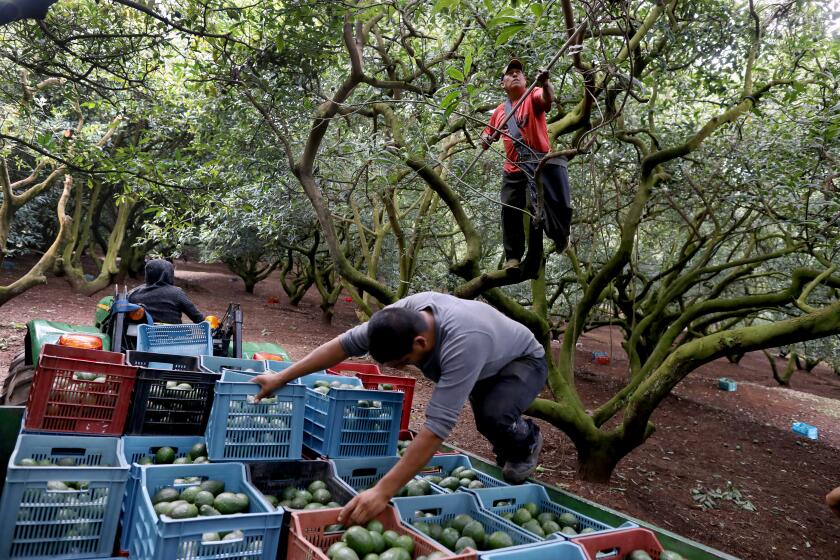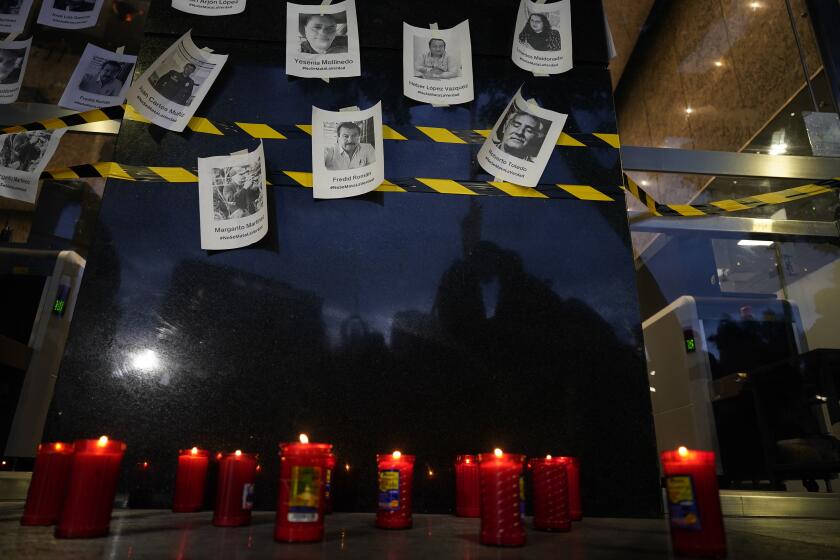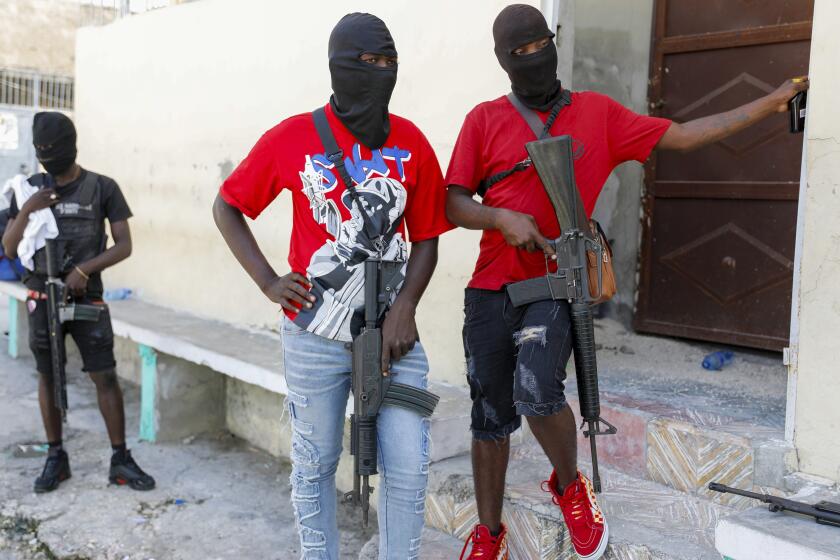
In one moment, a column of soldiers and military pickups creeps along a dirt road in western Mexico. In the next, a massive explosion sends debris and a body flying.
The ground where a soldier stood seconds earlier is a gaping hole, the aftermath of an improvised land mine planted by one of the region’s warring drug cartels.
That soldier was killed and four others were injured in the January explosion, which was captured in a grainy video that circulated on social media. Then last month, four more soldiers died and nine others were wounded when another explosive device detonated in the same region.
This week, three laborers were killed and two others injured by yet another mine, leaving a truck split in half and human remains scattered across a dusty road.

The series of blasts in the Tierra Caliente — an area along the border of Jalisco and Michoacán states that has long been a hot zone for cartel warfare — mark an alarming escalation of violence in Mexico as criminal groups arm themselves with ever-more sophisticated and deadly weaponry. The drug war in Mexico has come to resemble actual warfare.
For years the cartels have been engaged in an arms race, building powerful arsenals that now include grenade launchers, drones rigged with explosives and tank-like vehicles known as “monsters” that are equipped with machine gun turrets and steel armor.
But the widespread use of improvised land mines is new. Experts blame their rise in part on an influx into Mexico of mercenary fighters from Colombia, where explosives played a central role in a long-running war between leftist guerrilla groups and far-right paramilitaries.
The scourge of conflicts around the globe, abhorred for killing and maiming unsuspecting civilians and lingering hidden for decades, mines provide cartels with a tactical edge on the battlefield and widen the potential for collateral damage.
“You can kill more enemies from greater distance and limit direct confrontation,” said Tim Sloan, who headed the Mexico City office of the U.S. Bureau of Alcohol, Tobacco, Firearms and Explosives until 2022. “Less members can inflict more bodily harm while in enemy territory.”
As crime engulfs many Mexican states, immigrants who’ve saved to retire there are reevaluating ties to home — and whether returning is worth the risk.
Some of the devices have tripwires sensitive enough to be set off by pedestrians — not just the heavy armored trucks used by the military or cartels. “If a person, cow, vehicle, steps onto the switch it will explode,” Sloan said.
Last year, four police officers and two civilians were killed after an anonymous caller sent a tip about a clandestine burial site outside Guadalajara. Hidden along the road were improvised explosive devices, seven of which were set off as a convoy of police vehicles passed.
Amid growing concern about the problem, the U.S. government has increased its support to Mexican law enforcement and the military, donating bomb suits and detection equipment and training Mexican officials how to investigate crime scenes where explosives have detonated.
Mexico’s armed forces deactivated 2,241 improvised explosive devices in 17 states between August 2021 and July 2023, according to public records. Most were in Michoacán.
In the Tierra Caliente, where a patchwork of criminal groups is fighting soldiers, the powerful Jalisco New Generation cartel and one another, the new technology has brought fresh terror.

“You live in fear every day — of land mines, of drones, of assassins,” said a rancher from the outskirts of El Aguaje, a contested town on the front lines of a war between the Jalisco cartel — known by its Spanish initials, CJNG — and an alliance of criminal groups called the United Cartels. “You never know where you can safely step.”
The rancher, who spoke on condition of anonymity because he is afraid of cartel retribution, said the CJNG controlled the area until about four years ago, when a United Cartels faction from the neighboring municipality of Tepalcatepec began vying for power.
His pueblo, once a prosperous hub of lime farms, became a ghost town of abandoned homes pockmarked with bullet holes. Many residents fled to other parts of Mexico or the United States. The rancher left too, but two years later, after the federal government claimed it had regained control of the region, he returned.
The following day, one of his neighbors, a 79-year-old farmer named Cristobal, died after driving over an improvised land mine. The farmer’s son was badly injured.
It’s not just drugs. Mexico’s cartels are fighting over avocados.
Criminal groups have turned the region into a literal minefield, with a profound impact on daily life. The rancher, for example, said he has avoided a dirt road that winds from El Aguaje to Tepalcatepec ever since an armed man guarding it told him: “Go back. You can’t pass here and you know why.”
The man was from Colombia, the rancher said, part of a growing number of mercenaries who experts say have brought bomb-making technology to rural Mexico.
“There’s always been a conflict with shootouts and displacements, but lately you see other kinds of people who aren’t from here, who have a different accent,” said the rancher. He’s heard rumors that the foreigners fabricate improvised land mines and other explosives for the Tepalcatepec cartel leader known as El Abuelo — the Grandfather.
That account squares with Mexican military intelligence records reviewed by The Times that document foreign mercenaries, drone warfare and improvised land mines in the Tierra Caliente. U.S. officials and experts who study Mexico’s criminal landscape have tracked similar developments.


John P. Sullivan, an organized crime expert at USC’s Safe Communities Institute, said cartels have used improvised explosive devices sporadically since the 1990s, but they have become a mainstay of the conflict unfolding in the Tierra Caliente.
Sullivan said a small number of the mines appear to be military grade, and were probably smuggled into Mexico from the United States or nearby countries that have experienced armed conflict.
In 2018, suspected members of the Gulf cartel were arrested in the northern Mexican border city of Reynosa with two Claymore M18A1 antipersonnel mines — a weapon developed for the U.S. military.
But most of the explosives are improvised, Sullivan said, and probably made with the help of former soldiers and guerrilla fighters from Colombia, where a 2016 peace deal between the government and the nation’s biggest rebel group, the FARC, left many combatants unemployed. Using connections established through the cocaine trade, Mexican cartels began recruiting fighters for their own cause.
“They’re out of work. So what do they do?” Sullivan said. “Well, some of them have gone to work for other criminal organizations.”
Sloan said: “Homemade mortars, land mines, bomblets dropped by drones — all that technology was brought up by former FARC members working mainly with CJNG.”
Mexican military intelligence reports leaked by the hacktivist group Guacamaya in 2022 contain multiple references to Colombian mercenaries operating in the Aguililla region of Michoacán. One report, from September 2021, described the head of an “armed cell” working under El Abuelo as having 26 Colombian “guerrilleros” at his service in the fight against CJNG.

Another United Cartels boss had hired an additional 10 Colombians for the cause, paying them a weekly salary of around $600, according to the reports, which detail communications by cartel members as well as their battle plans.
The latest violence comes during an election year for Mexico, with President Andrés Manuel López Obrador set to leave office after a six-year term that has been tarnished by record levels of bloodshed. After sweeping into office on a campaign slogan of “hugs not bullets” and a pledge to end the drug war, he has been unable to lower the murder rate or take back vast swaths of the country that are firmly under cartel control.
Aguililla and neighboring municipalities in the Tierra Caliente have long vexed Mexico’s leaders. Frustrated by the inability of government forces to stamp out organized crime, townspeople in some communities have taken up arms in civilian-led militias.
In early 2022, the Mexican military swept into Aguililla, temporarily pushing out the CJNG. Mexican army minesweepers reportedly deactivated more than 250 antipersonnel mines during that campaign. The mayor held a public ceremony to celebrate the government forces bringing peace. Three weeks later, he was assassinated.
According to the leaked intelligence reports, Mexican soldiers heard one CJNG commander order his men to mine the roads around one stronghold and to place the explosives “in such a way so they won’t sink into the ground from vehicles or people without exploding.”
“What we want is to see them blown to bits over there,” said the commander, identified in the reports as Miguel Ángel Fernández Valencia, also known as M2.
Fernández Valencia, who was killed in a January 2022 shootout with Mexican soldiers, maintained a stockpile of explosives and bomb-making materials, according to the reports, including 10 sticks of dynamite — referred to as “sausages” — two sacks of ammonium nitrate fertilizer and electric switches and wiring for detonators.
In Michoacán, mines are increasingly used in tandem with weaponized drones, which Sullivan said give cartels “a decisive advantage in tactical engagements.”
El Chapo is in prison, but Sinaloa cartel remains strong. “This is a city filled with drug lords,” a Mexican journalist said. “We have 20 ‘El Chapos’ here.”
“It makes them more lethal and gives them more flexibility in their attacks,” he said. “It makes it harder for the military or police or any tactical unit to maneuver, because now it’s not just two-dimensional warfare on the ground, it’s three-dimensional warfare from the air.”
The crisis recently prompted security officials in Michoacán to form a specialized unit tasked with disposing of bombs.
The unit’s leader, Carlos Roberto Gómez Ruiz, said his team has deactivated 332 devices in just 2½ months. Most of them, he said, were discovered inside a single bomb-making workshop.

Gómez said the explosives are cobbled together from gas tanks, pipes, screws, nails and other readily available materials — each one a unique puzzle that can take his unit anywhere from a few minutes to several hours to crack.
“Each mission is different,” he said.
Gilberto Vergara Garcia, a Catholic priest who serves at the parish in Aguililla, said the new tactics of the cartels amount to “terrorism.”
“They have no right, no justification to create a situation of such imminent danger,” he said.
Even if the conflict one day is resolved, “all the residue and remnants of war will remain,” he said.
“The losers are always the locals, because they are the ones who in the end must deal with the terror of a land mine that these groups might forget.”
Hamilton reported from San Francisco and Linthicum from Mexico City.
More to Read
Start your day right
Sign up for Essential California for news, features and recommendations from the L.A. Times and beyond in your inbox six days a week.
You may occasionally receive promotional content from the Los Angeles Times.











